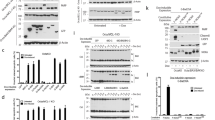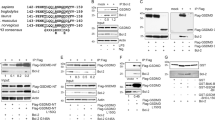Abstract
BCL-2 family proteins play a central role in apoptosis regulation in mammals and in C. elegans. Mammalian cellular and viral anti-apoptosis proteins such as BCL-2 and E1B-19K interact with several cellular proteins. Some of these interacting proteins promote apoptosis and belong to the BCL-2 family. Certain BCL-2 family pro-apoptotic proteins such as BAX and BAK share extensive sequence homology with BCL-2. In contrast, certain pro-apoptotic proteins such as BIK and BID share a single death effector domain, BH3, with other BCL-2 family proteins. By mutational analysis, we show that one of the cellular proteins, BNIP1 (previously Nip-1), that interacts with BCL-2 family anti-apoptosis proteins is a ‘BH3 alone’ pro-apoptotic protein. Transient transfection of BNIP1 induces a moderate level of apoptosis. Deletions of the N-terminal 32 amino acid region and the C-terminal trans-membrane domain did not significantly affect pro-apoptotic activity. In contrast, deletions encompassing a region containing a motif similar to the BH3-domain abrogated the apoptotic activity. Substitution of BNIP1 BH3 domain for the corresponding sequence in BAX efficiently restored the apoptotic activity of BAX, establishing the functional identity of the BH3 domain of BNIP1. The N-terminal deletions of BNIP1 (that retain the BH3 domain) enhanced the level of interaction with BCL-XL. Mutants containing the BH3 deletions were still able to heterodimerize with BCL-XL while mutants lacking both the N-terminal region and the BH3 domain were unable to heterodimerize, suggesting that BNIP1 may bind to BCL-XL via two different binding motifs.
This is a preview of subscription content, access via your institution
Access options
Subscribe to this journal
Receive 50 print issues and online access
$259.00 per year
only $5.18 per issue
Buy this article
- Purchase on Springer Link
- Instant access to full article PDF
Prices may be subject to local taxes which are calculated during checkout




Similar content being viewed by others
References
Boyd JM, Malstrom S, Subramanian T, Venkatesh LK, Schaeper U, Elangovan B, D'Sa-Eipper C and Chinnadurai G . 1994 Cell 79: 341–351
Boyd JM, Gallo GJ, Elangovan B, Houghton AB, Malstrom S, Avery BJ, Ebb RG, Subramanian T, Chittenden T, Lutz RJ and Chinnadurai G . 1995 Oncogene 11: 1921–1928
Chen G, Ray R, Dubik D, Shi L, Cizeau J, Bleackley RC, Saxena S, Gietz RD and Greenberg AH . 1997 J Exp Med 186: 1975–1983
Chen G, Cizeau J, Velde CV, Park JH, Bozek G, Bolton J, Shi L, Dubik D, Greenberg AH . 1999 J Biol Chem 274: 7–10.
Chou JJ, Li HL, Salvesen GS, Yuan JY and Wagner G . 1999 Cell 96: 615–624
Chittenden T, Flemington C, Houghton AB, Ebb RG, Gallo GJ, Elangovan B, Chinnadurai G and Lutz RJ . 1995 EMBO J 14: 5589–5596
Han J, Sabbatini P and White E . 1996 Mol Cell Biol 16: 5857–5864
Hunter JJ and Parslow TG . 1996 J Biol Chem, 1996 271: 8521–8524
Li HL, Zhu H, Xu CJ and Yuan JY . 1998 Cell 94: 491–501
Luo X, Budihardjo I, Zou H, Slaughter C and Wang XD . 1998 Cell 94: 481–490
Matsushima M, Fujiwara T, Takahashi E, Minaguchi T, Eguchi Y, Tsujimoto Y, Suzumori K and Nakamura Y . 1998 Genes Chromosomes & Cancer 21: 230–235
McDonnell JM, Fushman D, Milliman CL, Korsmeyer SJ and Cowburn D . 1999 Cell 96: 625–634
Simonian PL, Grillot DAM and Nunez G . 1997 Oncogene 15: 1871–1875
Yasuda M, Theodorakis P, Subramanian T and Chinnadurai G . 1998a J Biol Chem 273: 12415–12421
Yasuda M, D'Sa-Eipper C, Gong XL and Chinnadurai G . 1998b Oncogene 12: 2525–2530
Yasuda M, Han JW, Dionne CA, Boyd JM and Chinnadurai G . 1999 Cancer Res 59: 533–537
Zha HB, Aimesempe C, Sato T and Reed JC . 1996 J Biol Chem 271: 7440–7444
Zhang H, Heim J and Meyhack B . 1999 FEBS Lett 448: 23–27
Acknowledgements
This work was supported by research grants CA-33616 and CA-73803 from the National Cancer Institute and from a grant from the Charlotte Geyer Foundation.
Author information
Authors and Affiliations
Rights and permissions
About this article
Cite this article
Yasuda, M., Chinnadurai, G. Functional identification of the apoptosis effector BH3 domain in cellular protein BNIP1. Oncogene 19, 2363–2367 (2000). https://doi.org/10.1038/sj.onc.1203565
Received:
Revised:
Accepted:
Published:
Issue Date:
DOI: https://doi.org/10.1038/sj.onc.1203565



